Entity Framework
Entity Framework
Section titled “Entity Framework”Object Relational Mapping
Section titled “Object Relational Mapping”- Object oriented programming languages encapsulate data in objects.
- Relational databases are based on the mathematical concept of relational algebra.
- This conceptual discrepancy is called relational impedance mismatch.
Object Relational Mapping (2)
Section titled “Object Relational Mapping (2)”Object Relational Mapping is a programming technique that converts between data available in relational databases and objects in object-oriented programming languages.
Entity Framework Core is an implementation of a ORM for dotnet.
Object Relational Mapping (3)
Section titled “Object Relational Mapping (3)”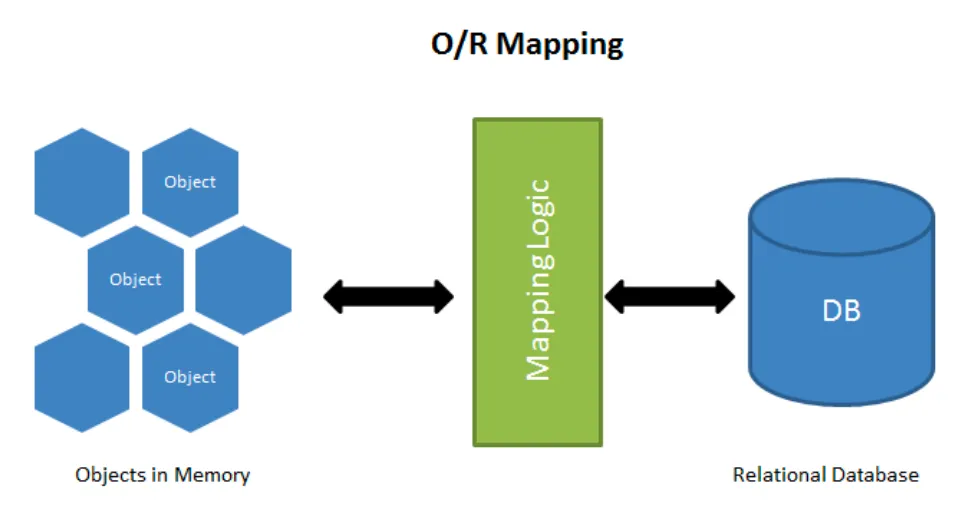
Basic Techniques
Section titled “Basic Techniques”- ORM maps classes to tables.
- One object corresponds to one row in a database table.
- Properties correspond to columns of a table.
- The Identity of one object is defined by the primary key of a table.
Basic Techniques (2)
Section titled “Basic Techniques (2)”- Data entries and foreign keys will be transformed to objects and references.
- When writing to the database, this conversion will be performed in the reversed direction.
Entity
Section titled “Entity”- An Entity is an object that can be stored into a database.
- To use an object as an entity, the object’s class must be registered within the database context of an application.
Entity - Default Mapping
Section titled “Entity - Default Mapping”When no further information is given, Entity Framework will try to guess how to map an entity to the database.
public class Dish { public int Id { get; set; } public string Name { get; set; } public string Description { get; set; } public float Price { get; set; }}CREATE TABLE DISH ( ID INT NOT NULL, NAME VARCHAR, DESCRIPTION VARCHAR, PRICE DECIMAL, PRIMARY KEY (ID))Entity - Define Mapping
Section titled “Entity - Define Mapping”Entity Framework uses 2 techniques to define the mapping between entities and the database.
- Annotations (C# Attributes)
- Fluent API (C# Method calls)
Annotation - Table
Section titled “Annotation - Table”By using the Table Annotation, you can specify the name of the table in the database.
[Table("DISHES")][Comment("Dish Entity")] // optionalpublic class Dish { public int Id { get; set; } // ...}Annotation - Required
Section titled “Annotation - Required”Properties that are marked with the Required attribute will get a not null constraint in the database.
[Table("DISHES")]public class Dish { public int Id { get; set; }
[Required] public string Name { get; set; }
[Required] public string Description { get; set; }
[Required] public float Price { get; set; }}Annotation - NotMapped
Section titled “Annotation - NotMapped”Properties marked with the NotMapped attribute, won’t be mapped to the database.
[Table("DISHES")]public class Dish { public int Id { get; set; } // ... [NotMapped] public DateTime LoadedFromDatabase { get; set; }}Annotation - Column
Section titled “Annotation - Column”The Column attribute defines the column name that should be used for a property.
[Table("DISHES")]public class Dish { [Column("DISH_ID")] public int Id { get; set; }
[Required] [Column("NAME", TypeName="VARCHAR(100)")] public string Name { get; set; }
[Column("DESCRIPTION", TypeName="VARCHAR(255)")] public string Description { get; set; }
[Required] [Column("PRICE", TypeName="DECIMAL(5,2)")] public float Price { get; set; }}Annotation - Key
Section titled “Annotation - Key”The Key attribute marks a column as primary key.
By default i property that is named Id or Id prefixed by the Classname (e.g. DishId) will be used as primary key.
[Table("DISHES")]public class Dish { [Column("DISH_ID")] [Key] [DatabaseGenerated(DatabaseGeneratedOption.Identity)] public int Id { get; set; } // ...}[Table("DISHES")]public class Dish { [Column("DISH_ID")] [Key] [DatabaseGenerated(DatabaseGeneratedOption.Identity)] public int Id { get; set; }
[Required, StringLength(100)] [Column("NAME")] public string Name { get; set; }
[Required] [Column("PRICE", TypeName="DECIMAL(5,2)")] public float Price { get; set; }}CREATE TABLE DISH ( DISH_ID INT NOT NULL AUTO INCREMENT, NAME VARCHAR(100) NOT NULL, PRICE DECIMAL(5,2) NOT NULL, PRIMARY KEY (DISH_ID))DbContext
Section titled “DbContext”The DbContext is the central interface to communicate with the database when using Entity Framework.
The DbContext class is used to resolve the Relational impedance mismatch.
DbContext (2)
Section titled “DbContext (2)”DbContext - Registering Entities
Section titled “DbContext - Registering Entities”- Classes that should be mapped to the database must be registered first.
- Registering happens by specifying a property of type DbSet for each class that should be mapped.
public class CookbookContext : DbContext { // Registering a class as entity public DbSet<Dish> Dishes { get; set; }
public CookbookContext( DbContextOptions<CookbookContext> options) : base(options) { // ... }}DbContext - Configuring Entities
Section titled “DbContext - Configuring Entities”The DbContext can also be used to configure entities. Configuring means to define the mapping.
Entities can be defined completely in the DbContext without using Annotations at all.
DbContext - Fluent API
Section titled “DbContext - Fluent API”public class CookbookContext : DbContext { // ... protected override void OnModelCreating( ModelBuilder builder) { builder.Entity<Dish>() .ToTable("DISHES") .Property(d => d.Name) .HasColumnName("TITLE") .HasColumnType("VARCHAR(50)") .IsRequired();
builder.Entity<Dish>() .Property(d => d.Description) // ... }}DbContext - Fluent API (2)
Section titled “DbContext - Fluent API (2)”public class CookbookContext : DbContext { protected override void OnModelCreating( ModelBuilder builder) { builder.Entity<Dish>() .HasKey(d => d.Id) .ValueGeneratedOnAdd(); }}DbContext - Fluent API (3)
Section titled “DbContext - Fluent API (3)”public class CookbookContext : DbContext { protected override void OnModelCreating( ModelBuilder builder) { builder.Entity<Dish>() .HasIndex(d => d.Name) .IsUnique(true); }}ORM - Advanced Concepts
Section titled “ORM - Advanced Concepts”ORM bridges the gap between relational databases and object-oriented programming.
Some concepts from object-oriented design must be considered specifically for the mapping.
- Inheritance
- Object References
- Composite keys
ORM - Inheritance
Section titled “ORM - Inheritance”Class inheritance is used in object-oriented design to define entities with similar properties in a hierarchical structure.
The relational design defines several different forms of inheritance.
ORM - Single Table Inheritance
Section titled “ORM - Single Table Inheritance”Single Table Inheritance saves all values of all (base and derived) entities into a single table.
This is also called Table-per-hierarchy configuration and is the default mapping strategy for inheritance when using Entity Framework Core.
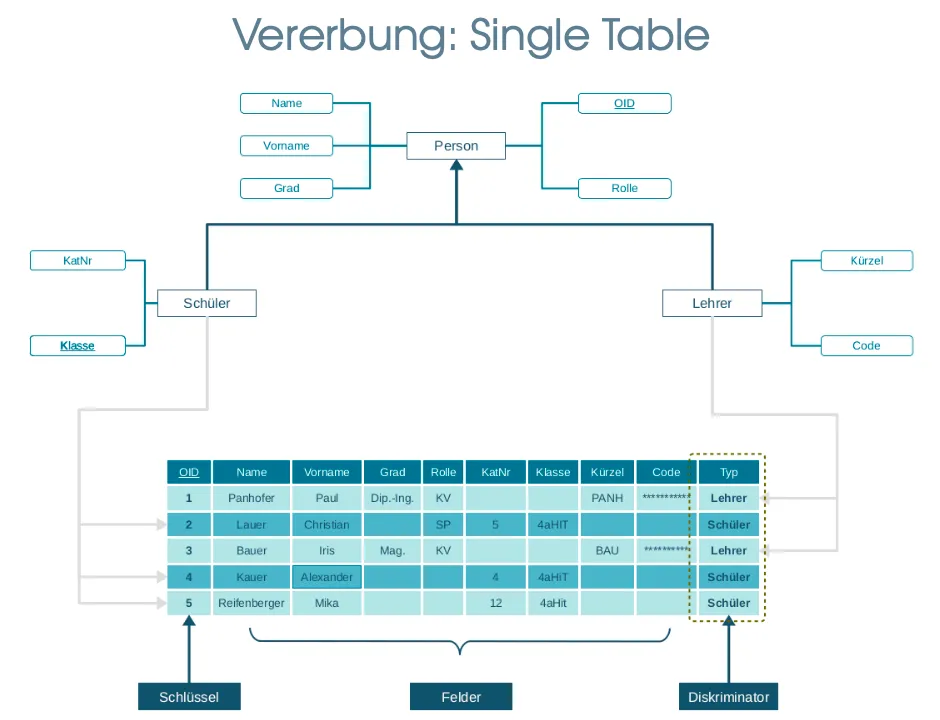
[Table("PERSONEN")]public class Person { [Key] [Column("OID")] public int Id { get; set; }
[Required, StringLength(100)] [Column("VORNAME")] public string FirstName { get; set; }
// ...}public class Student : Person { [Column("KAT_NR")] public int Code { get; set; }
[Required, StringLength(4)] [Column("KLASSE")] public string ClassCode { get; set; }}public class Teacher : Person { [Required, StringLength(4)] [Column("CODE")] public string Code { get; set; }
[Required, StringLength(2)] [Column("KUERZEL")] public string Short { get; set; }}public class UniversityContext : DbContext { protected override void OnModelCreating( ModelBuilder builder) { builder.Entity<Person>() .HasDiscriminator<string>("TYP") .HasValue<Student>("SCHUELER") .HasValue<Teacher>("LEHRER"); }}ORM - Joined Table Inheritance
Section titled “ORM - Joined Table Inheritance”The object data will be stored in a distributed way in multiple tables.
This is also called Table-per-type configuration.
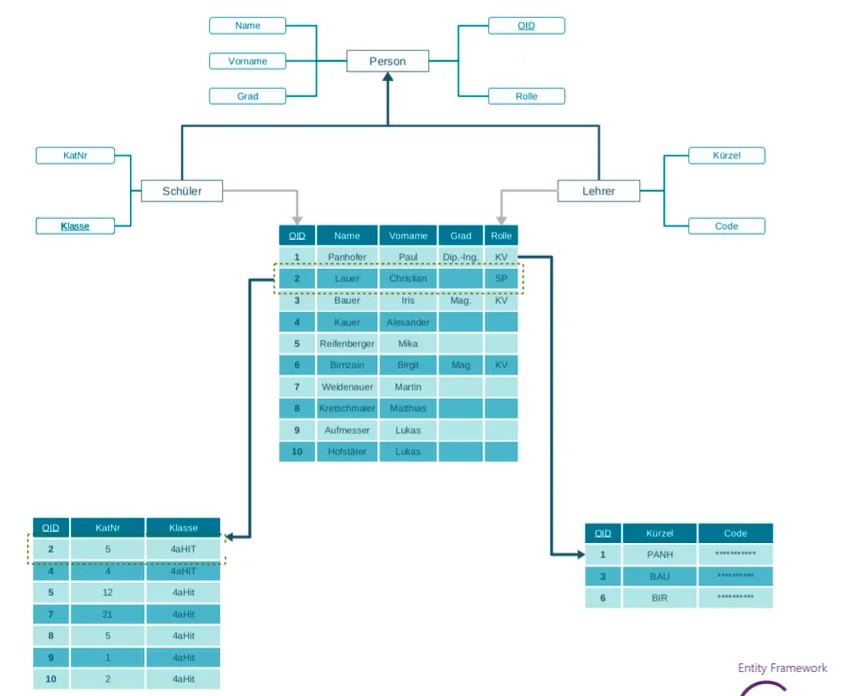
[Table("PERSONEN")]public class Person { [Key] [Column("OID")] public int Id { get; set; } // ... public string FirstName { get; set; } // ...}[Table("SCHUELER")]public class Student : Person { // ... public int Code { get; set; } // ... public string ClassCode { get; set; }}[Table("LEHRER")]public class Teacher : Person { // ... public string Code { get; set; } // ... public string Short { get; set; }}ORM - Table-per-concrete-Type Inheritance
Section titled “ORM - Table-per-concrete-Type Inheritance”In the TPC mapping pattern, all the types are mapped to individual tables. Each table contains columns for all properties on the corresponding entity type. This addresses some common performance issues with the TPT strategy.
public abstract class Animal{ protected Animal(string name) { Name = name; }
public int Id { get; set; } public string Name { get; set; } public abstract string Species { get; }
public Food? Food { get; set; }}
public abstract class Pet : Animal{ protected Pet(string name) : base(name) { }
public string? Vet { get; set; }
public ICollection<Human> Humans { get; } = new List<Human>();}
public class FarmAnimal : Animal{ public FarmAnimal(string name, string species) : base(name) { Species = species; }
public override string Species { get; }
[Precision(18, 2)] public decimal Value { get; set; }
public override string ToString() => $"Farm animal '{Name}' ({Species}/{Id}) worth {Value:C} eats {Food?.ToString() ?? "<Unknown>"}";}
public class Cat : Pet{ public Cat(string name, string educationLevel) : base(name) { EducationLevel = educationLevel; }
public string EducationLevel { get; set; } public override string Species => "Felis catus";
public override string ToString() => $"Cat '{Name}' ({Species}/{Id}) with education '{EducationLevel}' eats {Food?.ToString() ?? "<Unknown>"}";}
public class Dog : Pet{ public Dog(string name, string favoriteToy) : base(name) { FavoriteToy = favoriteToy; }
public string FavoriteToy { get; set; } public override string Species => "Canis familiaris";
public override string ToString() => $"Dog '{Name}' ({Species}/{Id}) with favorite toy '{FavoriteToy}' eats {Food?.ToString() ?? "<Unknown>"}";}
public class Human : Animal{ public Human(string name) : base(name) { }
public override string Species => "Homo sapiens";
public Animal? FavoriteAnimal { get; set; } public ICollection<Pet> Pets { get; } = new List<Pet>();
public override string ToString() => $"Human '{Name}' ({Species}/{Id}) with favorite animal '{FavoriteAnimal?.Name ?? "<Unknown>"}'" + $" eats {Food?.ToString() ?? "<Unknown>"}";}CREATE TABLE [Cats] ( [Id] int NOT NULL DEFAULT (NEXT VALUE FOR [AnimalSequence]), [Name] nvarchar(max) NOT NULL, [FoodId] uniqueidentifier NULL, [Vet] nvarchar(max) NULL, [EducationLevel] nvarchar(max) NOT NULL, CONSTRAINT [PK_Cats] PRIMARY KEY ([Id]));
CREATE TABLE [Dogs] ( [Id] int NOT NULL DEFAULT (NEXT VALUE FOR [AnimalSequence]), [Name] nvarchar(max) NOT NULL, [FoodId] uniqueidentifier NULL, [Vet] nvarchar(max) NULL, [FavoriteToy] nvarchar(max) NOT NULL, CONSTRAINT [PK_Dogs] PRIMARY KEY ([Id]));
CREATE TABLE [FarmAnimals] ( [Id] int NOT NULL DEFAULT (NEXT VALUE FOR [AnimalSequence]), [Name] nvarchar(max) NOT NULL, [FoodId] uniqueidentifier NULL, [Value] decimal(18,2) NOT NULL, [Species] nvarchar(max) NOT NULL, CONSTRAINT [PK_FarmAnimals] PRIMARY KEY ([Id]));
CREATE TABLE [Humans] ( [Id] int NOT NULL DEFAULT (NEXT VALUE FOR [AnimalSequence]), [Name] nvarchar(max) NOT NULL, [FoodId] uniqueidentifier NULL, [FavoriteAnimalId] int NULL, CONSTRAINT [PK_Humans] PRIMARY KEY ([Id]));ORM - Inheritance Summary
Section titled “ORM - Inheritance Summary”-
In summary, TPH is usually fine for most applications, and is a good default for a wide range of scenarios, so don’t add the complexity of TPC if you don’t need it. Specifically, if your code will mostly query for entities of many types, such as writing queries against the base type, then lean towards TPH over TPC.
-
That being said, TPC is also a good mapping strategy to use when your code will mostly query for entities of a single leaf type and your benchmarks show an improvement compared with TPH.
-
Use TPT only if constrained to do so by external factors.
ORM - 1:1 Relation
Section titled “ORM - 1:1 Relation”A 1:1 relation exists between 2 entities, if one of the entities has a reference to the other entity.
[Table("STUDENTS")]public class Student : Person { // ... public int Id { get; set; } // ... public string ClassCode { get; set; }}[Table("MATRICULATION_CARDS")]public class MatriculationCard { [Key] [DatabaseGenerated(DatabaseGeneratedOption.Identity)] public int Id { get; set; }
[Column("STUDENT_ID")] public int StudentId { get; set; }
public Student Student { get; set; }}public class UniversityContext : DbContext { protected override void OnModelCreating( ModelBuilder builder) { builder.Entity<MatriculationCard>() .HasOne(m => m.Student) .WithOne() .HasForeignKey<MatriculationCard>(m => m.StudentId); }}ORM - 1:n Relation
Section titled “ORM - 1:n Relation”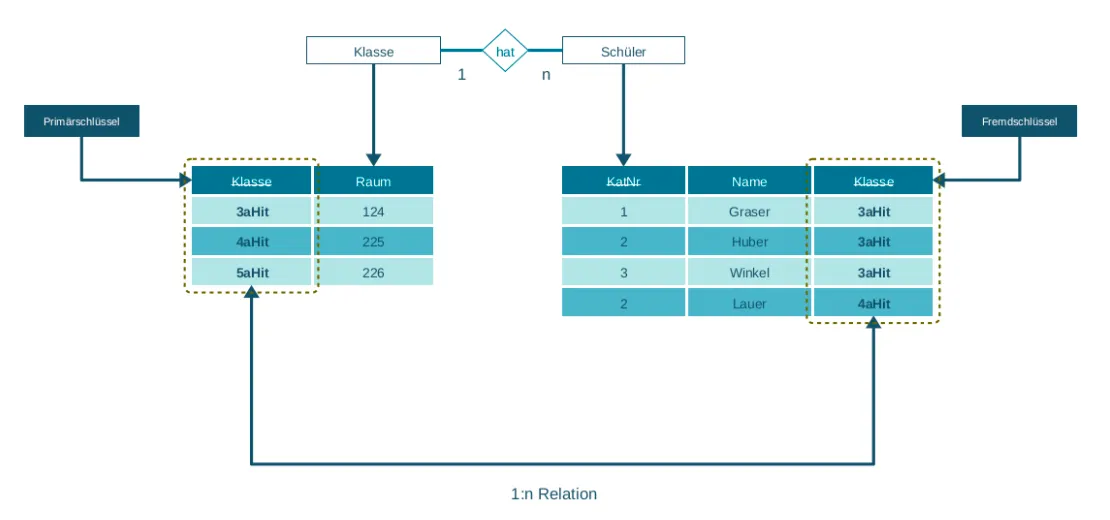
[Table("CLASS_ROOMS")]public class ClassRoom { [Column("ROOM_CODE"), StringLength(4)] [Key] public string ClassId { get; set; }
public ICollection<Student> Students { get; set; }}[Table("SCHUELER")]public class Student { [Column("STUDENT_ID")] [Key] [DatabaseGenerated(DatabaseGeneratedOption.Identity)] public int Id { get; set; } // ... public ClassRoom Room { get; set; } [Column("CLASS_CODE")] public string ClassId { get; set; }}public class UniversityDbContext : DbContext { protected override void OnModelCreating( ModelBuilder builder) { builder.Entity<Student>() .HasOne(s => s.Room) .WithMany(r => r.Students) .HasForeignKey(s => s.ClassId); }}ORM - m:n Relation
Section titled “ORM - m:n Relation”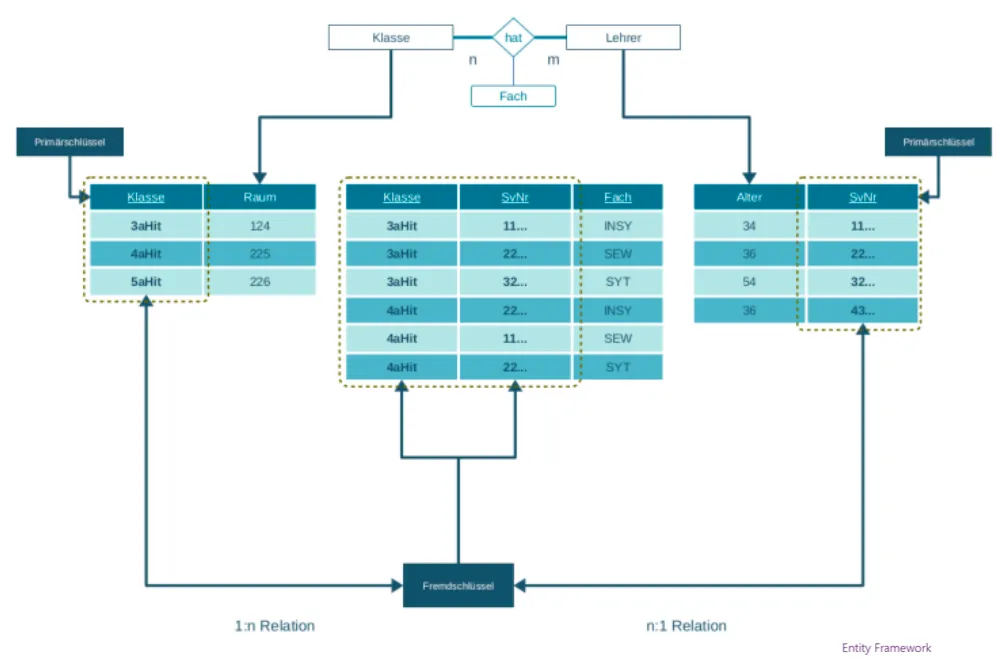
[Table("CLASS_ROOMS")]public class ClassRoom { [Column("KLASSE")] [Key] public string ClassId { get; set; }
[Required, StringLength(3)] [Column("RAUM")] public string RoomCode { get; set; }}[Table("KLASSE")]public class Teacher { [Column("SVNR")] [Key] public int SocialSecurity { get; set; }
[Required, Range(0, 200)] [Column("ALTER")] public int Age { get; set; }}[Table("TIME_TABLES_JT")]public class LectureAssignment { [Column("SVNR")] public int SocialSecurity { get; set; } public Teacher Teacher { get; set; }
[Column("CLASS_ROOM_CODE")] public string ClassId { get; set; } public ClassRoom ClassRoom { get; set; }
[Required, StringLength(20)] [Column("COURSE")] public string Course { get; set; }}public UniversityContext : DbContext { protected void OnModelCreated(ModelBuilder builder) { builder.Entity<LectureAssignment>() .HasKey(l => new { l.SocialSecurity, l.ClassId });
builder.Entity<LectureAssignment>() .HasOne(l => l.Teacher) .WithMany() .HasForeignKey(l.SocialSecurity);
builder.Entity<LectureAssignment>() .HasOne(l => l.ClassRoom) .WithMany() .HasForeignKey(l.ClassId); }}Layers / Tiers
Section titled “Layers / Tiers”We typically build up our applications in layers. (Tier is just a synonym for layer.)
Each layer is responsible for one specific purpose. Splitting up responsibilities is also often referred to as separation of concerns.
One layer only communicates with the layers right next to itself, but never skips a layer.
3 Tier Architecture
Section titled “3 Tier Architecture”The 3 tier architecture is one of the most widely used approaches in how to structure software.
The three layers used in this architecture are as follows.
Data Access Layer
Section titled “Data Access Layer”- Synonyms:
- DAL
- Model
- Data Layer
Responsible for accessing (reading/writing) data. Very often this means accessing a database, but how to persist data is not standardized. You could have a data access layer that stores data to files just as well. When using C# the data access layer often is implemented using an ORM like Entity Framework.
Business Logic Layer
Section titled “Business Logic Layer”- Synonyms:
- BL
- Logic
- Domain
This layer is responsible for processing information. We work on a higher level than accessing individual database tables. Additionally to using the DAL for accessing single tables the BL can contain more complex operations including multiple datasets and other systems such as an e-mail service.
Presentation Layer
Section titled “Presentation Layer”- Synonyms:
- View
- Service Layer
The presentation layer presents the information to the user and offers possibilities to modify it. Very often the presentation layer will be a (web-) application. In a way a simple API, such as a REST-API can also be considered a presentation layer in the context of a three-tier architecture.
Domain Layer - Repository
Section titled “Domain Layer - Repository”The repository pattern is a widely used way to structure your code to get reusable functionality to access data.
The IRepository interface connects the presentation layer and the domain layer.
IRepository
Section titled “IRepository”The IRepository is a generic interface. This means it can be implemented for different entities. Users of the IRepository might want to use a IRepository<Teacher> or a IRepository<Pupil> to access either teacher data or pupil data.
public interface IRepository<TEntity> where TEntity : class { // ...}IRepository - Create
Section titled “IRepository - Create”public interface IRepository<TEntity> where TEntity : class {
// Create a new entity TEntity Create(TEntity t);
// Create multiple entities List<TEntity> CreateRange(List<TEntity> list);}IRepository - Update
Section titled “IRepository - Update”public interface IRepository<TEntity> where TEntity : class {
// Modify an entity void Update(TEntity t);
// Modify multiple entities void UpdateRange(List<TEntity> list);}IRepository - Read
Section titled “IRepository - Read”public interface IRepository<TEntity> where TEntity : class {
TEntity? Read(int id);
List<TEntity> Read( Expression<Func<TEntity, bool>> filter );
List<TEntity> Read(int start, int count);
List<TEntity> ReadAll();}IRepository - Delete
Section titled “IRepository - Delete”public interface IRepository<TEntity> where TEntity : class { void Delete(TEntity t);}ARepository
Section titled “ARepository”Instead of implementing all the interface methods for each entity, we use an abstract base class where we implement all these functionalities once, that doesn’t differ between different entities.
public abstract class ARepository<TEntity> : IRepository<TEntity> where TEntity : class { protected DbContext _context; protected DbSet<TEntity> _table;
protected ARepository(DbContext context) { _context = context; _table = context.Set<TEntity>(); }}ARepository - Create
Section titled “ARepository - Create”public abstract class ARepository<TEntity> : IRepository<TEntity> where TEntity : class {
public TEntity Create(TEntity t) { _table.Add(t); _context.SaveChanges(); return t; }
public List<TEntity> CreateRange(List<TEntity> list) { _table.AddRange(list); _context.SaveChanges(); return list; }}ARepository - Update
Section titled “ARepository - Update”public abstract class ARepository<TEntity> : IRepository<TEntity> where TEntity : class {
public void Update(TEntity t) { _table.Update(list); _context.SaveChanges(); }
public void UpdateRange(List<TEntity> list) { _table.UpdateRange(list); _context.SaveChanges(); }}ARepository - Read
Section titled “ARepository - Read”public abstract class ARepository<TEntity> : IRepository<TEntity> where TEntity : class {
public List<TEntity> Read( Expression<Func<TEntity, bool>> filter) => _table.Where(filter).ToList();
public List<TEntity> Read(int start, int count) => _table.Skip(start) .Take(count) .ToList();
public List<TEntity> ReadAll() => _table.ToList();}ARepository - Delete
Section titled “ARepository - Delete”public abstract class ARepository<TEntity> : IRepository<TEntity> where TEntity : class {
public void Delete(TEntity t) { _table.Remove(t); _context.SaveChanges(); }}